 When your seekers look at the church, what do they see? I wonder if they see a pyramid — with the bishops and priests at the top, supported from below by the laity. Honestly, that’s the way I saw the church throughout my childhood and most of my teen years. It is the way the structure of the church was taught before the Second Vatican Council. The role of the laity was to help the clergy in their vocation.
When your seekers look at the church, what do they see? I wonder if they see a pyramid — with the bishops and priests at the top, supported from below by the laity. Honestly, that’s the way I saw the church throughout my childhood and most of my teen years. It is the way the structure of the church was taught before the Second Vatican Council. The role of the laity was to help the clergy in their vocation.
Vatican II turned that notion upside down. Instead of being a part of the church that assists the clergy, the baptized faithful are the church. All the ministries of the church derive from baptism. Those in specialized roles, such as the clergy, are supposed to serve the common priesthood, that is, the priesthood of the baptized.
While the common priesthood of the faithful is exercised by the unfolding of baptismal grace —a life of faith, hope, and charity, a life according to the Spirit — the ministerial priesthood is at the service of the common priesthood. It is directed at the unfolding of the baptismal grace of all Christians. (Catechism of the Catholic Church, 1547)
How the landscape of the church changed
This was a huge shift in the thinking of the church, and we’re still getting used to it. The notion that the laity exercise a common priesthood that is at the heart of the identity and mission of the church generated some opposition at the Second Vatican Council. But the majority of the bishops, under the guidance of the Holy Spirit prevailed. The teaching on the laity is found in two documents from the Council: The Constitution on the Church and the Decree on the Apostolate of the Laity.
The Decree on the Apostolate of the Laity says that the laity have their own true vocation, not just a participation in the vocation of the clergy. This vocation is grounded in our baptism.
And what exactly is our vocation? What is our baptismal job description? It is to “[spread] the kingdom of Christ throughout the earth” (Decree on the Apostolate of the Laity, 2). The church calls this goal the “apostolate,” and all of us are bound to work actively in the apostolate. No one can remain passive. “Indeed, … the member who fails to make his proper contribution to the development of the Church,” said the bishops, “must be said to be useful neither to the Church nor to himself” (Decree on the Apostolate of the Laity, 2).
In order to accomplish this important goal, we have to have the same zeal as the first apostles. “In fact, modern conditions demand that [the laity’s] apostolate be broadened and intensified” (Decree on the Apostolate of the Laity, 1).
Why your ministry is so important
So who is going to do this broadening and intensifying? Who is going to instill this apostolic zeal into the laity?
Well, that would be us — all of us who are working in the ministry of initiation. Others have this responsibility as well, but no one more so than those of us who serve on RCIA teams. The Rite of Christian Initiation of Adults says:
Since the Church’s life is apostolic, catechumens should also learn how to work actively with others to spread the Gospel and build up the Church by the witness of their lives and by professing their faith.
Everything we do with the catechumens and the candidates should be focused on developing in them an apostolic zeal for spreading the gospel. In a future post, we’ll look more at what that means for us and for them.
Your Turn
Until then, please add your comments below about your understanding of our apostolic vocation. When did you first realize you had a vocation as member of the common priesthood of the baptized? How has that realization shaped your life as a Catholic?


















I think I first understood that the “pyramid” vision of the Church was wrong when i was working with an inquirer. The catechetical leaflet I was using explained the ministries by starting at the top and coming ondown to the laity, so I drew the pyramid on a piece of paper and then the inquirer and I added in the ministerial roles in their proper places. But I made sure that we added the laity I(and the catechumens, who were in the Church but not yet fully initiated). But it felt wrong to me. So I asked the inquirer to imagine that the “pyramid” was viewed “from the air,” so to speak. When you look down on a pyramid, it looks like a circle with concentric rings. Clearly there are more laity than clergy, and they are no more or less important than the smaller group of ministers. This diagram has problems too, but it works better than the pyramid.
This message is so timely. I still read articles and statements that imply that the “church” is an institution ,
The “church” is identified with the clergy, people in religious life and perhaps some prominent lay leaders.
People “join” the church.
But perhaps we should say that we “become” the church when we are baptized. We are all the church and we need to act as if we believe this.
Let us not forget that they ARE at the top, as far as authority goes. They rightly exercise that authority for the benefit of the People of God, but nonetheless they have that authority:
“Extraordinary gifts are not to be sought after… but judgment as to their genuinity and proper use belongs to those who are appointed leaders in the Church, to whose special competence it belongs, not indeed to extinguish the Spirit, but to test all things and hold fast to that which is good.”
There are two attributes which I see to be the great highlight of the common priesthood of the baptized. These two characteristics are also constantly under challenge, and threat of worldliness, and even avoidance.
These are the notions of personal responsibility and individual accountability.